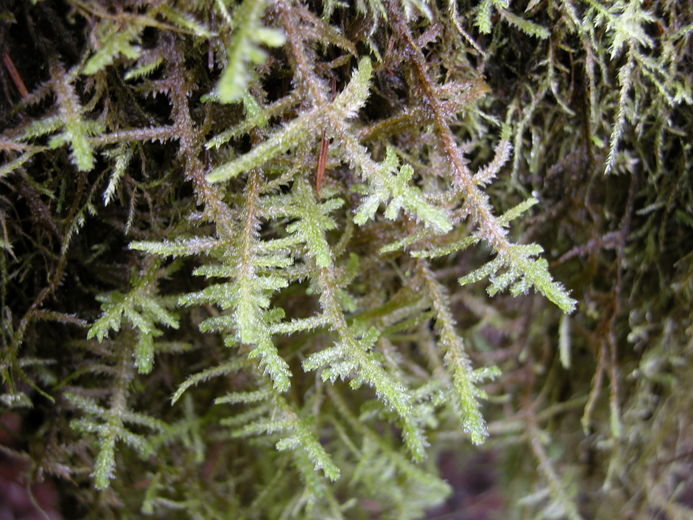Neckera Hedwig, 1801.

photo by C. Wagner
NEEDS GENUS PARAGRAPH
Key to Neckera Etc.
The plants treated here are either truly dendroid mosses (discussed under Antitrichia), or they are plumose mosses with complanate leaf arrangement. The monotypic genus Bestia is here treated despite its plumose branching and more or less julaceous leaf arrangement. Because the circumscription of the Neckeraceae remains in some uncertainty, Bestia has shuffled between the Neckeraceae and the Brachytheciaceae.
Species included in this key are in Neckeraceae, except Bestia (Brachytheciaceae), Climacium (Climaciaceae), and Leucolepis (Mniaceae):
Bestia longipes (Sullivant & Lesquereux) Brotherus
Bryolawtonia vancouveriensis (Kindberg) Norris & Enroth
Climacium dendroides (Hedwig) Weber & D. Mohr
Homalia trichomanoides (Hedwig) W. P. Schimper, not known from CA
Leucolepis acanthoneura (Schwägrichen) Lindberg
Metaneckera menziesii (Drummond) W. C. Steere
Neckera douglasii W. J. Hooker
Porotrichum bigelovii (Sullivant) Kindberg
Thamnobryum neckeroides (W. J. Hooker) E. Lawton
Most of the plants in this key are easily identified. Students may sometimes confuse the expressions "complanate-foliate" and "planar branched." Planar branching is a feature of the branching independent of the apparent flat arrangement of the leaves. Many mosses with complanate leaves may be prostrate on the substratum with the branching therefore appearing planar, but the plumose plants here in the Neckeraceae key have the branches lifted somewhat off the substratum with those branches remaining in a single plane.
A. Leaves complanate; plant not dendroid but sometimes irregularly plumose .....B
A. Leaves not complanate; plant mostly dendroid to plumose .....F
B. Leaves strongly undulate .....C
B. Leaves not at all undulate .....D
C. Leaves ecostate; leaf apex acute to acuminate, strongly dentate, mostly with some of the teeth recurved in the plane of the leaf; paraphyllia absent .....Neckera douglasii
C. Leaves with strong costa reaching above mid-leaf; leaf apices blunt to obtuse, serrulate to nearly entire; paraphyllia densely arranged on main stems and branches .....Metaneckera: M. menziesii
D. Juxtacostal cells in median leaf 4-8:1; leaves usually more than 1.5 mm long; margin of most leaves broadly recurved near the base on one side .....Porotrichum: P. bigelovii
D. Juxtacostal median cells shorter; not much longer than median marginal cells; leaves shorter .....E
E. Leaves to 1 mm long; alar cells quadrate in a small but poorly defined group .....Bryolawtonia: B. vancouveriensis
E. Leaves larger; alar cells not at all differentiated .....Homalia: H. trichomanoides not known from CA
F. Leaf margin with somewhat elongate cells forming a somewhat differentiated limbidium; leaves of stem bleached and deltoid-triangular, markedly different from those of the branches .....Leucolepis: L. acanthoneura
F. Leaf margin without a limbidium; stem leaves not so different from those of branches .....G
G. Paraphyllia arranged in parallel lines along stems and branches; distal portion of costa without abaxial spines or cristae .....Climacium: C. dendroides
G. Paraphyllia absent; distal portion of costa with abaxial spines or cristae .....H
H. Leaf apices obtuse and coarsely dentate; alar cells irregularly quadrate to rectangular, not well differentiated; leaves not plicate or recurved .....Thamnobryum: T. neckeroides
H. Leaf apices mostly acute; alar cells markedly greener than adjacent laminal cells, quadrate and thick-walled with rounded lumina; leaves somewhat plicate and recurved near base .....Bestia: B. longipes

